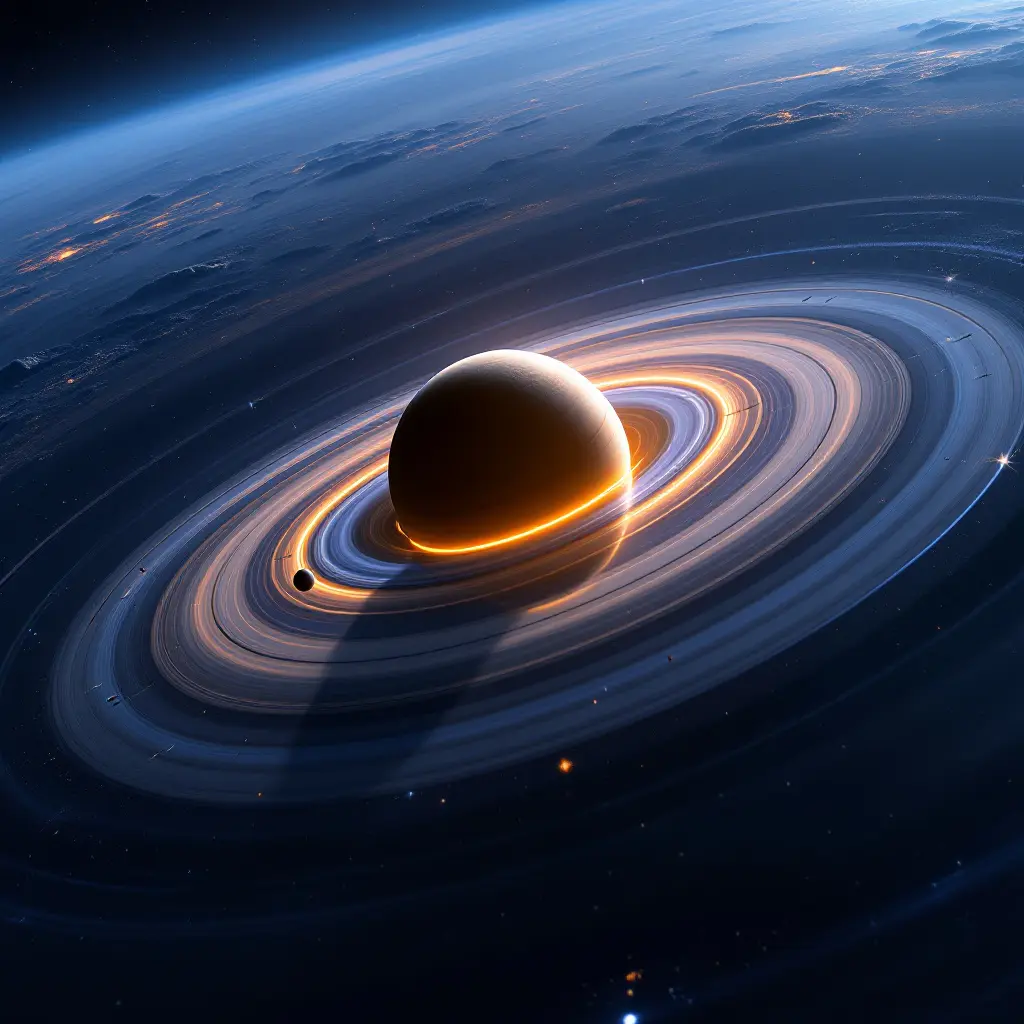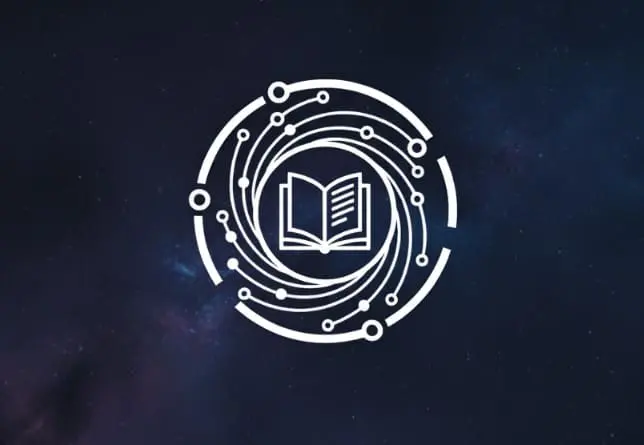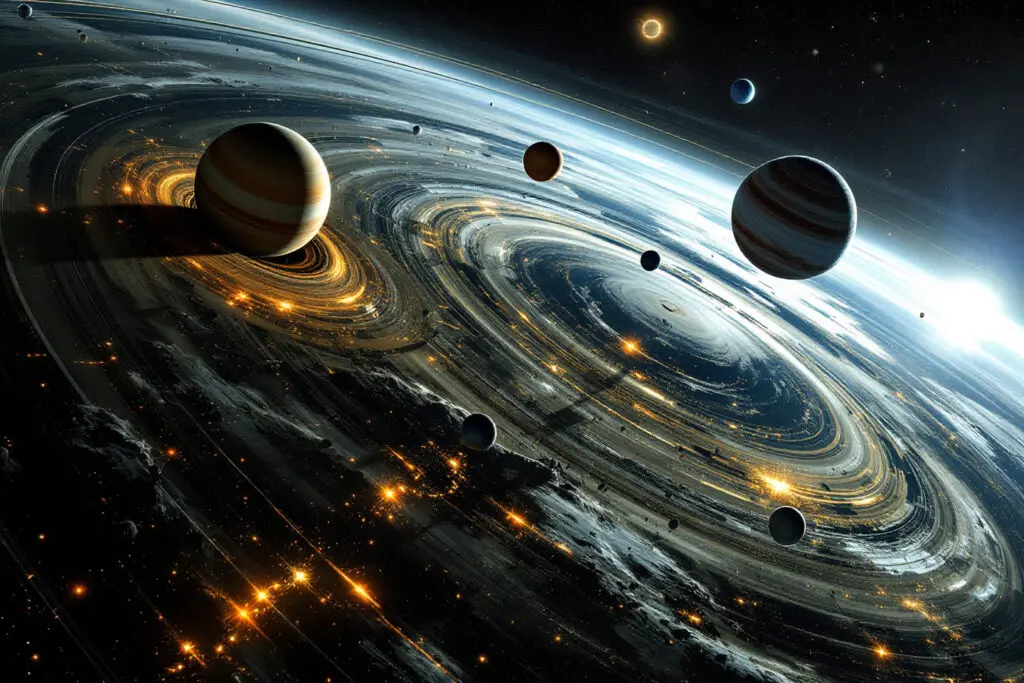What do you see when you picture the solar system? For most of us, it’s a tidy, predictable model. The Sun sits in the middle, and the planets spin around it on what looks like a single, flat cosmic record. Mercury, Venus, Earth, Mars, and the gas giants beyond—they all follow the rules, orbiting on a level playing field.
And then there’s Pluto. Pluto is the cosmic rebel. It doesn’t just march to a different beat; it dances to a symphony playing in another room entirely. The heart of its strangeness, and what makes it endlessly fascinating, is the orbital inclination of Pluto. Its journey is tilted and stretched-out, a path unlike anything else in the main planetary lineup.
So, why doesn’t Pluto just get in line? This is no simple quirk of nature. The story behind Pluto’s tilted orbit is a blockbuster tale of gravitational wars, a violent and chaotic past, and the beautiful, complex dance of celestial bodies. This story shatters our neat little models. It reveals a solar system far more dynamic and frankly, more interesting than we ever imagined. To understand Pluto’s wild ride, we have to dive deep into the very formation of our cosmic neighborhood, looking back billions of years to a time when planets weren’t where they are now and collisions were just business as usual. Let’s unravel this mystery together.
More in Celestial Mechanics Category
How Orbital Eccentricity Shapes Orbits
Key Takeaways
- Pluto’s Orbit Isn’t Flat: While the eight major planets circle the Sun on a relatively flat plane (the ecliptic), Pluto’s path is jacked up at a steep 17-degree angle.
- The Ecliptic is the Standard: Most things in the solar system were born from the same spinning disk of primordial stuff, which is why they share a common orbital plane. Pluto’s severe tilt is a major clue that its history is different.
- Neptune Pulls the Strings: Pluto and Neptune are locked in a stable gravitational rhythm called a 3:2 mean-motion resonance. For every three trips Neptune makes around the Sun, Pluto makes exactly two. This cosmic timing prevents them from ever colliding.
- A Deeper Force is at Work: A process called the Kozai-Lidov mechanism, driven by Neptune’s gravity, is thought to have cranked up Pluto’s inclination. It works by trading orbital tilt for orbital stretch (eccentricity) over millions of years, explaining both of Pluto’s signature quirks.
- A Chaotic Past Forged the Present: The leading theory is that the giant planets migrated long ago. This planetary shuffle tossed smaller bodies like Pluto into new, wild orbits. Neptune likely “swept up” Pluto, locking it into the tilted, resonant state we see today.
What’s This “Flat” Solar System You’re Talking About?
Before we can grasp how much of an oddball Pluto really is, we need a baseline for “normal.” That baseline is something astronomers call the ecliptic plane.
Think of it this way. Our solar system started as a colossal, spinning cloud of gas and dust. As gravity collapsed this cloud to ignite the Sun at its heart, the leftover material flattened into a huge, rotating disk—like a chef spinning pizza dough. The planets were born from this disk.
Since they all formed from the same spinning, flat material, they kept that momentum. They all travel around the Sun in the same direction and on roughly the same level. That common level is the ecliptic. It’s not perfect, of course. Space is never that tidy. But the major planets don’t stray far.
So, How Well-Behaved Are the Other Planets?
The eight main planets stick to the script remarkably well. Imagine the ecliptic is the center line on a cosmic highway. Some may drift a bit, but they all stay safely within the lines.
By definition, Earth’s orbital inclination is 0 degrees—we use our own path to define the plane itself. The others show only slight tilts relative to us:
- Mercury: The biggest rule-breaker of the main eight, with a 7-degree tilt.
- Venus: A calm 3.4 degrees.
- Mars: A barely-there 1.85 degrees.
- Jupiter: A very respectable 1.3 degrees.
- Saturn: Tilted at about 2.5 degrees.
- Uranus: The teacher’s pet, at a mere 0.77 degrees.
- Neptune: A tidy 1.77 degrees.
They all hover right there, within a few degrees of the plane. They’re all moving in the same cosmic lane. And then there’s Pluto, taking an off-road adventure high above everyone else.
How Wild Is Pluto’s Orbit, Really?
Putting Pluto’s orbit next to the other planets is like comparing a roller coaster to a carousel. The planets cruise. Pluto swoops. Its journey is both incredibly steep and noticeably stretched.
That 17-degree inclination is no small thing. It’s more than double the tilt of Mercury. If you looked at a flat map of the solar system, it would seem like Pluto and Neptune are destined to smash into each other. For a long time, this was a source of serious confusion.
But that map is missing a dimension.
In 3D, the real picture emerges. Pluto’s path is so inclined that when it “crosses” Neptune’s orbit, it’s either way above it or way below it. Think of a highway overpass. They never actually touch. For about 20 years of its 248-year trip around the Sun, Pluto is actually closer to us than Neptune is. It’s a bizarre setup, and that 17-degree tilt makes it all possible.
Is Pluto the Only Weirdo Out There?
For decades, Pluto seemed utterly unique. A cosmic fluke. But as our telescopes got better, we started finding more objects out beyond Neptune, in a vast, icy expanse called the Kuiper Belt. And it turns out, Pluto is far from alone. It’s just one of the biggest kids in a whole class of objects with strange, tilted, stretched-out orbits.
Take Eris, another dwarf planet, with a mind-boggling orbital inclination of 44 degrees. Or Sedna, whose orbit is so vast and eccentric it takes over 11,000 years to go around the Sun just once. Finding these other “trans-Neptunian objects” (TNOs) changed the game. It proved Pluto wasn’t the exception; it was a prime example of the chaos out in the solar system’s frontier. The question morphed from “Why is Pluto so weird?” to “What in the world happened out there?”
The main suspect in this cosmic case file? Neptune.
Is Neptune the Gravitational Bully of the Outer Solar System?
Blaming Neptune for Pluto’s behavior might seem odd. The two are billions of miles apart. But in space, gravity has a long and patient reach. The connection between Neptune and Pluto is the single most critical piece of this puzzle. It’s a relationship built on a complex, elegant, and rock-solid gravitational lock.
They are trapped in what scientists call a “mean-motion resonance.”
It sounds technical, but it’s really just about timing. For every three orbits Neptune completes, Pluto completes exactly two. This is the 3:2 resonance. It’s no accident. It’s a gravitational sweet spot the two bodies fell into billions of years ago, and it’s the key to Pluto’s survival.
Imagine two people running on a track, one faster (Neptune) and one slower (Pluto). The resonance ensures the faster runner never laps the slower one at an awkward, collision-prone spot. Thanks to this perfect timing, whenever Pluto gets near Neptune’s orbital path, Neptune is always somewhere else entirely. They can never get close enough for a catastrophic encounter.
So This Cosmic Rhythm Prevents a Crash?
Exactly. The 3:2 resonance is Pluto’s shield. It choreographs their orbital dance to make a collision impossible. When Pluto is at its closest point to the Sun (a point called perihelion), it actually ducks inside Neptune’s orbit. But at that moment, Neptune is guaranteed to be at least 5 billion miles away. They are perpetually out of sync in a way that ensures they both survive.
This arrangement is incredibly stable. Our best computer models show this relationship has lasted for billions of years and will likely last for billions more. It’s a permanent piece of our solar system’s architecture.
But here’s the kicker. This resonance doesn’t just explain how Pluto stays safe. It’s also the key to how its orbit got so tilted. The very force that protects Pluto is the same one that twisted its path. It’s a complicated relationship.
Is There a Deeper, Weirder Force at Work?
The 3:2 resonance explains the timing, but it doesn’t quite explain the 17-degree tilt. How does being locked with Neptune cause Pluto to soar so high above the ecliptic? For that, we need to introduce a more subtle, long-term process: the Kozai-Lidov mechanism.
This is where the story gets really wild. The Kozai-Lidov mechanism describes how a distant, massive object can stir up the orbit of a smaller one. It creates a multi-million-year cycle where the small body’s inclination and its eccentricity (how much its orbit is stretched) are traded back and forth.
In this system, Neptune is the massive perturber. Over immense timescales, its steady gravitational tug makes Pluto’s orbit oscillate. As Pluto’s tilt increases, its orbit becomes more circular. Then, the cycle reverses: its tilt decreases, and its orbit becomes more stretched out.
How Can Gravity Actually Tilt an Orbit Like That?
Think of Pluto as a spinning top and Neptune’s gravity as a constant, gentle pressure on the surface it’s spinning on. That pressure doesn’t knock the top over. Instead, it makes its spin wobble and precess in a very specific, predictable way. The Kozai-Lidov mechanism is simply the physics that describes that wobble.
For Pluto, this means Neptune’s relentless gravity has, over eons, “pumped up” its inclination. The energy to lift Pluto’s entire orbit so far from the ecliptic had to come from somewhere. The mechanism shows that this energy was basically stolen from the orbit’s shape, its eccentricity. This is why Pluto’s orbit is both highly inclined and highly eccentric. The two features are two sides of the same coin, both forged by Neptune’s long-range gravitational influence.
This mechanism connects the dots. Pluto isn’t just in resonance with Neptune. It’s that this stable resonance creates the perfect conditions for the Kozai-Lidov effect to work its magic for billions of years, slowly sculpting Pluto’s path into the strange shape it has today.
Did the Solar System Start Out This Messy?
We have our culprit and the mechanism. But we still need the origin story. How did Pluto get snared in this gravitational trap in the first place? It certainly wasn’t born that way. The answer probably lies in a violent period of upheaval early in our solar system’s life, a scenario called the Nice model (named for the city in France where the idea originated).
This model suggests that the giant planets—Jupiter, Saturn, Uranus, and Neptune—were not born in their current orbits. They formed much closer to the Sun and to each other. The early solar system was a more crowded place. And just beyond them lay a massive, dense disk of icy leftovers, the stuff Pluto is made of.
Things were quiet for a few hundred million years. But eventually, the giant planets started gravitationally interacting with this huge debris disk. The interaction caused them to move. They started to migrate. Jupiter drifted slightly inward, while Saturn, Uranus, and Neptune were shoved outward.
And This Planetary Shuffle Wreaked Havoc on Pluto?
Neptune’s outward push was the big one. As it plowed into the primordial Kuiper Belt, its gravity acted like a cosmic snowplow. It flung countless icy bodies in every direction. Some were shot into the inner solar system, causing the destructive era known as the Late Heavy Bombardment. Others were ejected into the far reaches of space.
And some, like Pluto, got caught.
As Neptune moved out, its powerful orbital resonances moved with it. Before this, Pluto and its neighbors were likely in nice, flat, circular orbits. But as Neptune’s 3:2 resonance swept through their neighborhood, it captured them. Pluto was swept up and locked in.
Once captured, Pluto had no choice but to move with Neptune. As the gas giant continued its outward trek, it dragged Pluto along, stretching its orbit further and further. This process naturally inflated Pluto’s eccentricity. Once the orbit was stretched enough, the Kozai-Lidov mechanism kicked in, converting that stretch into the high inclination we see today. This one theory brilliantly explains not just Pluto, but the whole family of tilted, resonant objects out in the Kuiper Belt. They are the frozen survivors of that ancient migration, their strange orbits a lasting monument to the solar system’s chaotic adolescence. For a deeper dive on planetary migration, check out NASA’s Solar System Exploration resources.
Could a Giant Smash-Up Have Contributed?
While planetary migration is the leading explanation, it may not be the only chapter in this story. Some researchers think a direct, catastrophic impact could have played a part. In fact, we have strong evidence that Pluto was once slammed by another massive object, something nearly its own size.
This giant impact theory is the best explanation we have for Pluto’s largest moon, Charon. The collision would have been world-shattering, blasting tons of Pluto’s crust and mantle into orbit, which then clumped together to form Charon. It’s a story very similar to how our own Moon likely formed after an ancient impact with Earth.
An impact that big would be apocalyptic. The energy released would be enough to reshape a world, alter its spin, and maybe even jolt its orbit. It’s certainly plausible that a powerful enough blow could have helped knock Pluto onto a more inclined path, a tilt that was then magnified by its subsequent dance with Neptune. This idea doesn’t replace the migration theory; it complements it. The early solar system was a cosmic shooting gallery. It’s very likely that both large-scale planetary movement and brutal, one-off collisions worked together to make the worlds we see today.
How Does This Weird Orbit Affect Pluto’s Status?
Pluto’s strange path is more than a scientific curiosity. It sits at the very center of the passionate, and often heated, debate over whether it’s a planet. In 2006, the International Astronomical Union (IAU) made the controversial call to reclassify Pluto as a “dwarf planet.” To do so, they laid out three rules for what makes a planet:
- It must orbit the Sun.
- It has to be massive enough for its gravity to have squished it into a round or nearly round shape.
- It must have “cleared the neighborhood” around its orbit.
Pluto nails the first two. No problem. It orbits the Sun, and it’s definitely round. But it fails, spectacularly, on rule number three. Its tilted, resonant orbit is exhibit A in the case against it.
What Does “Clearing the Neighborhood” Even Mean?
This rule means a planet has to be the gravitational boss of its own orbital zone. It has either swallowed, captured, or kicked out all the other significant debris in its path. Earth has a clean orbit. We don’t share our lane with other large bodies.
Pluto, however, is the king of the Kuiper Belt, but it’s a kingdom filled with subjects it can’t control. Its orbit is shared with countless other icy worlds. Its path is defined not by its own power, but by the gravitational rhythm it must keep with Neptune. The very fact that this resonance exists is proof that Pluto has not cleared its neighborhood. It is, in a very real way, living in Neptune’s gravitational territory and abiding by Neptune’s rules.
The orbital inclination of Pluto is a direct, visible symptom of this status. Its wild, tilted path isn’t the stately procession of a body that has carved out its own domain. It is the path of a survivor—a body that was pushed around, captured, and ultimately sculpted by the gravitational might of a giant. It is the beautiful, complex, and defiant orbit of a dwarf planet.
Pluto’s tilt isn’t a defect. It’s a feature. It’s a history book written in the language of orbital mechanics, telling an epic story of our evolving solar system. It’s a reminder that our cosmic home isn’t a static display case but a living, breathing system, full of ancient secrets and intricate connections. The next time you picture the solar system, don’t just see the flat, neat disk. See the overpass, the roller coaster, the grand, tilted path of Pluto, and appreciate the beautiful chaos that put it there.
FAQ – Orbital Inclination of Pluto

What role did early planetary migration and possible collisions play in shaping Pluto’s orbit?
Early planetary migration, especially Neptune’s outward movement, likely captured Pluto into its current tilted orbit and resonant relationship, with possible impacts further amplifying its inclination through gravitational disturbances.
Was the solar system originally composed of planets with more inclined orbits like Pluto?
No, the current high inclinations and eccentricities, including Pluto’s, are believed to result from a period of planetary migration and chaotic events early in the solar system’s history, which caused these bodies to be captured into their current orbits.
How does Pluto’s resonance with Neptune protect it from collisions?
Pluto and Neptune are locked in a 3:2 mean-motion resonance, meaning for every three orbits Neptune makes, Pluto completes two, and this gravitational resonance ensures they never collide by maintaining a safe spatial relationship.
Why does Pluto have such a high orbital inclination compared to other planets?
Pluto’s high inclination is primarily caused by the Kozai-Lidov mechanism, driven by Neptune’s gravitational influence, which over millions of years has increased Pluto’s tilt and eccentricity through a complex gravitational dance.
What makes Pluto’s orbit different from that of the main planets in the solar system?
Pluto’s orbit is significantly tilted at an angle of 17 degrees relative to the ecliptic plane, which is much steeper than the orbits of the eight major planets that stay close to this flat plane.

